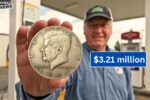A rare 1944 steel penny, a tiny coin worth a staggering $1.9 million, has coin collectors and everyday folks buzzing with excitement. This wartime error coin, accidentally struck in steel instead of copper, is one of the rarest pennies ever made. What’s even more thrilling is that some of these coins might still be hiding in pocket change, old jars, or forgotten collections across the United States. With a recent sale making headlines, here’s everything you need to know about this valuable penny, how it came to be, and how to spot one.
A Wartime Mistake Creates a Treasure
During World War II, the U.S. Mint switched to steel pennies in 1943 to save copper for the war effort. By 1944, pennies were back to being made from copper, but a few steel blanks from 1943 were mistakenly used at the Philadelphia, Denver, and San Francisco mints. These 1944 steel pennies are incredibly rare, with only 25 to 40 believed to have been made in Philadelphia and even fewer in Denver and San Francisco. One such coin, from the San Francisco mint, sold for $1.9 million at a private auction, sparking renewed interest in this numismatic gem.
Why Are These Pennies So Valuable?
The value of the 1944 steel penny comes from its rarity and historical significance. With over two billion copper pennies minted in 1944, the few steel ones stand out as errors. Collectors prize them for their scarcity and the story behind their creation. For example, a 1944-S steel penny in top condition (MS66 grade) fetched $408,000 in 2021, while a Philadelphia-minted one in MS64 grade sold for $180,000 the same year. The $1.9 million sale of another 1944-S penny set a new record, showing how demand for these coins keeps growing. Some errors, like a double-struck “IN GOD WE TRUST” or an off-center design, can push values even higher.
How to Spot a 1944 Steel Penny
If you’re wondering whether you’ve got a million-dollar penny in your change, here’s how to check:
- Use a magnet: Steel pennies stick to magnets, unlike copper ones.
- Check the date: Look for “1944” on the front of the penny.
- Look for a mint mark: A small “S” (San Francisco), “D” (Denver), or no mark (Philadelphia) appears below the date.
- Examine the color: Steel pennies look silver, not coppery.
Be cautious, though some 1944 copper pennies were coated to look like steel, and fakes exist. Always have a suspected steel penny authenticated by a professional service like PCGS or NGC to confirm its value.
Could One Still Be in Circulation?
Experts believe a few 1944 steel pennies might still be out there, overlooked in coin rolls, piggy banks, or old collections. Because they’re magnetic, some were mistaken for foreign coins or tossed aside as novelties. The U.S. Mint’s mistake likely happened when leftover 1943 steel blanks were accidentally fed into 1944 presses, possibly during production of Belgian two-franc coins at the Philadelphia mint. With so few made, finding one in circulation is like winning the lottery, but stories of rare coins turning up keep hope alive. For instance, recent finds of valuable bicentennial quarters and Roosevelt dimes have fueled excitement among collectors.
Auction Records and Market Trends
The 1944 steel penny has smashed auction records over the years. Here’s a look at some notable sales:
| Year | Mint | Grade | Auction Price | Date |
|---|---|---|---|---|
| 2007 | Denver | MS63 | $115,000 | August 9, 2007 |
| 2013 | Philadelphia | MS64 | $158,625 | 2013 |
| 2021 | San Francisco | MS66 | $408,000 | August 22, 2021 |
| 2021 | Philadelphia | MS64 | $180,000 | 2021 |
These prices show how condition and rarity drive value. Even lower-grade steel pennies can fetch $26,500 to $42,500, making them a dream find for collectors. The coin market is hot right now, with rising gold and silver prices encouraging more people to hunt for treasures in their change.
Tips for Coin Hunters
If you want to search for a 1944 steel penny, start by checking old coin collections, estate sales, or even loose change from vending machines. Use a magnet to test any silver-looking 1944 penny, but don’t get your hopes up too high only a handful exist. Joining a local coin club or following numismatic websites can keep you updated on rare finds. If you think you’ve found one, contact a reputable coin dealer or grading service for authentication. With a bit of luck and a keen eye, you could uncover a piece of history worth a fortune.




